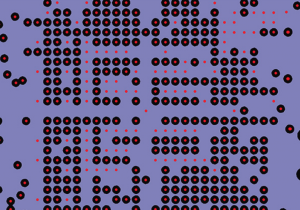Previous post, we have discussed the size of solder mask opening design tip.
If you want to protect your LED PCB board circuits, you should read it.
But you know PCB board has two part composition, circuits and holes.
Even the hole has many types, so this post will focus on the vias of the LED PCB board design.
Always Use Direct Connect for Vias
Do not use thermal pads or location dots at via hole locations on internal plane layers.
They are unnecessary, and in the case of tightly-spaced vias, multiple thermal pads may overlap to the extent that all of the tie connections may be removed from one or more vias.
The result will be an open circuit (“starved thermal”) condition.
Your fabricator’s pre-production CAM department typically fills location dots before the artwork is plotted for manufacturing.
Since the dots are not useful for production, and may actually create problems if they are not filled, it is best to omit them at the design stage.

All vias in the violet plane areas are direct-connect, with no thermal pads and no small location dots. This is the correct appearance for vias connecting to planes.
—
From epectec, original author have all right.
Original title:TOP 10 PRINTED CIRCUIT BOARD DESIGN CHECKS
MCPCB experts recommend top 10 design tips:
- Avoid Placing Vias at the End of SMT Pads
- Do Not Route Wide Traces Into Narrow SMT Pads
- Do Not Route Traces Along Sides of SMT Pads.
- Route All Traces at 90 Degrees or Greater
- Don’t Place Components Too Close to the PCB Outline
- Never Export English-Unit Gerber or Drill Files at 2:3 Decimal Resolution
- Size Your Solder Mask Openings Consistently
- Always Use Direct Connect for Vias
- Size Your Component Hole Thermal Pads Appropriately
- Allow Enough Clearance Between Unsupported PTHs and Adjacent Copper Features on Internal Layers
